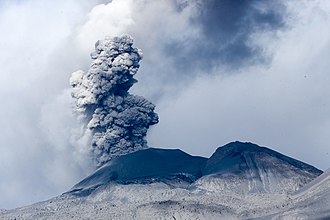
Back Vulkaan Afrikaans Vulkan ALS እሳተ ገሞራ Amharic Vulcán AN Fȳrbeorg ANG ज्वालामुखी ANP بركان Arabic بركان (جيولوجيا) ARY بركان ARZ আগ্নেয়গিৰি Assamese

A volcano is a rupture in the crust of a planetary-mass object, such as Earth, that allows hot lava, volcanic ash, and gases to escape from a magma chamber below the surface.
On Earth, volcanoes are most often found where tectonic plates are diverging or converging, and because most of Earth's plate boundaries are underwater, most volcanoes are found underwater. For example, a mid-ocean ridge, such as the Mid-Atlantic Ridge, has volcanoes caused by divergent tectonic plates whereas the Pacific Ring of Fire has volcanoes caused by convergent tectonic plates. Volcanoes can also form where there is stretching and thinning of the crust's plates, such as in the East African Rift and the Wells Gray-Clearwater volcanic field and Rio Grande rift in North America. Volcanism away from plate boundaries has been postulated to arise from upwelling diapirs from the core–mantle boundary, 3,000 kilometers (1,900 mi) deep within Earth. This results in hotspot volcanism, of which the Hawaiian hotspot is an example. Volcanoes are usually not created where two tectonic plates slide past one another.
Large eruptions can affect atmospheric temperature as ash and droplets of sulfuric acid obscure the Sun and cool Earth's troposphere. Historically, large volcanic eruptions have been followed by volcanic winters which have caused catastrophic famines.[1]
Other planets besides Earth have volcanoes. For example, volcanoes are very numerous on Venus.[2] In 2009, a paper was published suggesting a new definition for the word ‘volcano’ that includes processes such as cryovolcanism. It suggested that a volcano be defined as ‘an opening on a planet or moon’s surface from which magma, as defined for that body, and/or magmatic gas is erupted.’[3]
This article mainly covers volcanoes on Earth. See § Volcanoes on other celestial bodies and Cryovolcano for more information.
- ^ Rampino, M R; Self, S; Stothers, R B (May 1988). "Volcanic Winters". Annual Review of Earth and Planetary Sciences. 16 (1): 73–99. Bibcode:1988AREPS..16...73R. doi:10.1146/annurev.ea.16.050188.000445.
- ^ Hahn, Rebecca M.; Byrne, Paul K. (April 2023). "A Morphological and Spatial Analysis of Volcanoes on Venus". Journal of Geophysical Research: Planets. 128 (4). Bibcode:2023JGRE..12807753H. doi:10.1029/2023je007753. ISSN 2169-9097. S2CID 257745255.
- ^ Lopes1, Mitchell2, Williams3, Mitri4, Gregg5, R. M.1, K. L.2, D. A.3, G.4, T. K.5. "What is a Volcano? How planetary volcanism has changed our definition". Astrophysics Data System.
{{cite web}}: CS1 maint: multiple names: authors list (link) CS1 maint: numeric names: authors list (link)